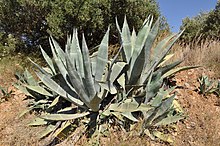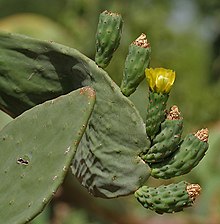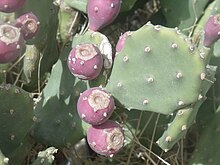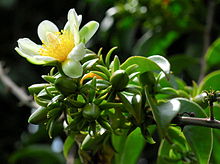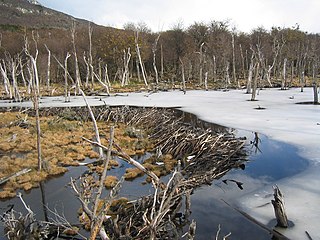
An invasive species is an introduced organism that negatively alters its new environment. Although their spread can have beneficial aspects, invasive species adversely affect the invaded habitats and bioregions, causing ecological, environmental, and/or economic damage. Sometimes the term is used for native species that invade human habitats and become invasive pests. In the 21st century they have become a serious economic, social, and environmental threat.
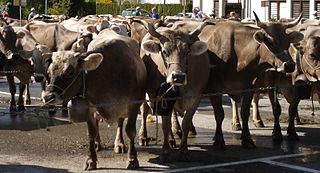
An introduced species, alien species, exotic species, adventive species, immigrant species, foreign species, non-indigenous species, or non-native species is a species living outside its native distributional range, but which has arrived there by human activity, directly or indirectly, and either deliberately or accidentally. Non-native species can have various effects on the local ecosystem. Introduced species that become established and spread beyond the place of introduction are considered "naturalized". The process of human-caused introduction is distinguished from biological colonization, in which species spread to new areas through "natural" (non-human) means such as storms and rafting.
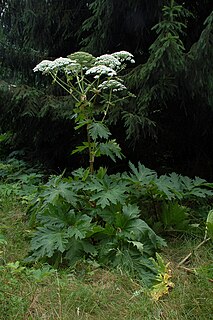
Heracleum mantegazzianum, commonly known as giant hogweed, is a monocarpic perennial herbaceous flowering plant in the carrot family Apiaceae. H. mantegazzianum is also known as cartwheel-flower, giant cow parsley, giant cow parsnip, or hogsbane. In New Zealand, it is also sometimes called wild parsnip or wild rhubarb.

A number of introduced species, some of which have become invasive species, have been added to New Zealand's native flora and fauna. Both deliberate and accidental introductions have been made from the time of the first human settlement, with several waves of Polynesian people at some time before the year 1300, followed by Europeans after 1769.

Centranthus ruber, also called red valerian, spur valerian, kiss-me-quick, fox's brush, devil's beard and Jupiter's beard, is a popular garden plant grown for its ornamental flowers.

Leucadendron strobilinum, commonly called the peninsula conebush, is a plant species in the genus Leucadendron—forming part of the family Proteaceae. Confined to the Cape Peninsula, it reaches a height of up to 2.6 metres growing in southern, damp rocky slopes at an elevation of 500 to 1100m. Its conservation status is Near Threatened—a result of inappropriate fire management, fire-break clearing and alien plant invasions.

Lagarosiphon major is a monocotic aquatic plant native to Southern Africa. Common names include African elodea, curly waterweed, oxygen weed and South African oxygen weed. It is used as freshwater aquarium plant.

Cape Flats Sand Fynbos (CFSF), previously known as Sand Plain Fynbos, is a critically endangered vegetation type that occurs only within the city of Cape Town. Less than 1% of this unique lowland fynbos vegetation is conserved.

Peninsula Shale Renosterveld (PSR) is a unique vegetation type that is found only on the slopes of Signal Hill and Devil's Peak in Cape Town, South Africa. It is critically endangered and exists nowhere else.

Swartland Shale Renosterveld is a critically endangered vegetation type of the Western Cape, South Africa.

Raapenberg Bird Sanctuary is a 10-hectare (25-acre) protected area in Cape Town, located on the Liesbeek river near the suburb of Observatory.

Zandvlei Estuary Nature Reserve is a 300-hectare (740-acre) nature reserve and recreational area located in Cape Town, South Africa.

De Hel Nature Area is a 21.3-hectare (53-acre) nature reserve protecting a river valley and indigenous forest on the lower eastern slopes of Table Mountain, Cape Town, South Africa.

Meadowridge Common is an 8-hectare (20-acre) reserve in the Meadowridge suburb of Cape Town, South Africa, which preserves a fragment of critically endangered Cape Flats Sand Fynbos vegetation.

Wolfgat Nature Reserve is a coastal nature reserve in Mitchells Plain on False Bay in the Western Cape, South Africa.

Uitkamp Wetland Nature Reserve is a 32-hectare (79-acre) wetland reserve located in Durbanville in the Western Cape province of South Africa.

Durbanville Nature Reserve is a 6-hectare (15-acre) piece of protected land, located next to the Durbanville Racecourse in the Western Cape, South Africa.

Macassar Dunes Conservation Area is a 1,116-hectare (2,760-acre) coastal nature reserve in Macassar, within the City of Cape Town, South Africa.
The Biodiversity of South Africa is the variety of living organisms within the boundaries of South Africa and its exclusive economic zone. South Africa is a region of high biodiversity in the terrestrial and marine realms. The country is ranked sixth out of the world's seventeen megadiverse countries, and is rated among the top 10 for plant species diversity and third for marine endemism.
